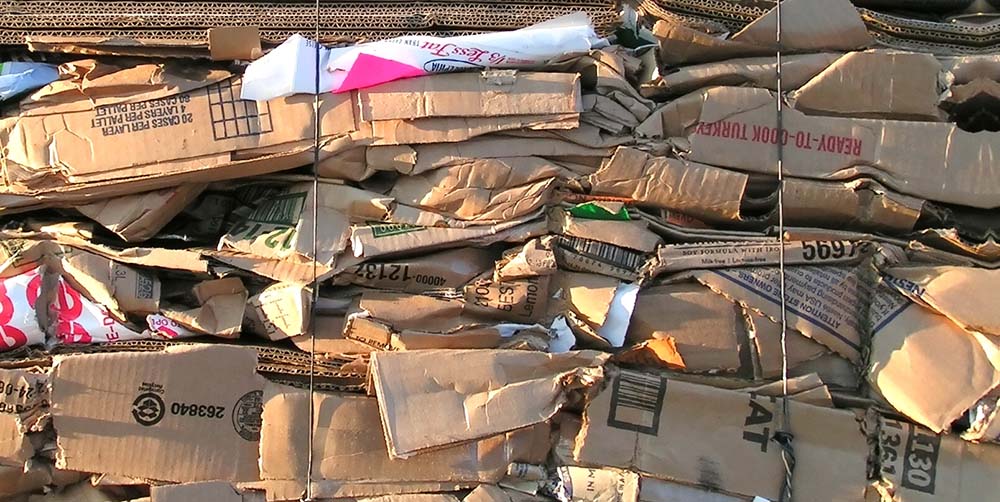Analysis of Paper and Cardboard

Background
Paper/cardboard wastes can constitute a large proportion of MSW and are a distinct resource in instances where they are collected separately. The paper sludge wastes of paper mills, containing fibres too short for paper production, are also a potential biomass resource.Paper made from hardwoods tends to be smoother (and therefore easier to write and print on) than paper from softwoods but softwood paper also tends to be weaker. The fibres from hardwoods and softwoods can be blended into a single paper type, with the proportional quantities varying according to preferences for strength, whiteness, and roughness, among other properties.
Celignis founder Daniel Hayes has considerable experience in the chemical and near-infrared analysis of papers and cardboards, having undertaken a study, funded by the Irish Environmental Protection Agency, that involved this. That study involved collecting and characterising a wide variety of samples identified, by a previous EPA study, as being major contributors to the paper/cardboard fraction of MSW. Such samples included: newspapers, printing paper, receipts, paper bags, and packaging papers/cardboards.
Analysis of Paper and Cardboard at Celignis
Celignis Analytical can determine the following properties of Paper and Cardboard samples:
Sugars (Monosaccharides)
Sugar Alcohols and Uronic Acids
Lignin and Extractives
- Lignin (Klason)
- Lignin (Klason - Protein Corrected)
- Lignin (Acid Soluble)
- Acid Insoluble Residue
- Extractives (Ethanol-Soluble)
- Extractives (Water-Soluble)
- Extractives (Exhaustive - Water then Ethanol)
- Lignin S/G Ratio
- Extractives (Water-Insoluble, Ethanol Soluble)
- Protein Content of Acid Insoluble Residue
- Carbon Content of Acid Insoluble Residue
- Hydrogen Content of Acid Insoluble Residue
- Nitrogen Content of Acid Insoluble Residue
- Sulphur Content of Acid Insoluble Residue
Amino
Acids
Thermal Properties
- Moisture
- Ash
- Ash (Acid Insoluble)
- Carbon
- Hydrogen
- Nitrogen
- Sulphur
- Oxygen
- Volatile Matter
- Fixed Carbon
- Gross Calorific Value
- Net Calorific Value
- Chlorine
- Ash Shrinkage Starting Temperature (Oxidising)
- Ash Deformation Temperature (Oxidising)
- Ash Hemisphere Temperature (Oxidising)
- Ash Flow Temperature (Oxidising)
- Ash Shrinkage Starting Temperature (Reducing)
- Ash Deformation Temperature (Reducing)
- Ash Hemisphere Temperature (Reducing)
- Ash Flow Temperature (Reducing)
- Thernogram - Under Nitrogen
- Thermogram - Under Air
Major and Minor Elements
Cellulose Content of Paper and Cardboard
Papers typically have high cellulose contents. This means that such samples could be excellent feedstocks for hydrolysis biroefining technologies, although the CaCO3 filler in some paper may affect acid-catalysed hydrolysis.Click here to see the Celignis Analysis Packages that determine cellulose content.
Hemicellulose Content of Paper and Cardboard
The hemicellulose content, and the type of sugars that make up the hemicellulose, will be greatly dependent on what proportion of hardwood and softwood has been used to produce the paper/cardboard.Click here to see the Celignis Analysis Packages that determine hemicellulose content.
Lignin Content of Paper and Cardboard
The lignin content of papers and cardboards can vary significantly, with small amounts in some samples (e.g. tissues and printing paper) but much greater amounts in others (e.g. newspapers and corrugated cardboards). The type and severity of pulping used will determine the amount of lignin that is retained in the final sample.Click here to see the Celignis Analysis Packages that determine lignin content.
Starch Content of Paper and Cardboard
Starch can be an important constituent in determining paper properties and can be added to achieve the desired effect. For this reason it can vary between different paper and cardboard types and direct analysis is often warranted.Click here to see the Celignis Analysis Packages that determine starch content.
Uronic Acid Content of Paper and Cardboard
The uronic acid content and composition of papers and cardboards will depend on the pulping process used.Click here to read more about uronic acids and to see the Celignis Analysis Packages that determine uronic acid content.
Enzymatic Hydrolysis of Paper and Cardboard
We can undertake tests involving the enzymatic hydrolysis of Paper and Cardboard. In these experiments we can either use a commercial enzyme mix or you can supply your own enzymes.We also offer analysis packages that compare the enzymatic hydrolysis of a pre-treated sample with that of the native original material.
Click here to read more about enzymatic hydrolysis and to see the various analysis packages that we offer.
Ash Content of Paper and Cardboard
The ash content of papers/cardboards can vary significantly. Glossy materials can have particularly high ash contents. High ash contents and some of the additives in paper may cause problems in some combustion and thermochemical technologies.Click here to see the Celignis Analysis Packages that determine ash content.
Heating (Calorific) Value of Paper and Cardboard
As with the chemical constituents, the heating value of papers and cardboards has wide variation. A high ash content in the sample will be to the detriment of the heating value. A lower lignin:carbohydrate ratio would also be detrimental.Click here to see the Celignis Analysis Packages that determine heating value.
Bulk Density of Paper and Cardboard
At Celignis we can determine the bulk density of biomass samples, including Paper and Cardboard, according to ISO standard 17828 (2015). This method requires the biomass to be in an appropriate form (chips or powder) for density determination.Click here to see the Celignis Analysis Packages that determine bulk density.
Basic Density of Paper and Cardboard
At Celignis we can determine the basic density of some suitable biomass samples. The method requires the biomass to be in an appropriate form (chips) for density determination.Click here to see the Celignis Analysis Packages that determine basic density.
| Previous Feedstock | Next Feedstock |
Go Back to List of Feedstocks.
Energy
Crops
Agricultural Residues and Wastes
Industrial Residues and Wastes
Municipal
Wastes
Biorefinery
Products






